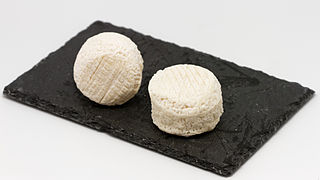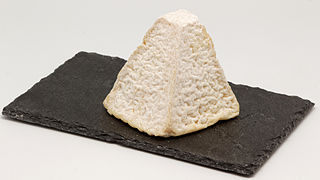
Gruyère is a hard Swiss cheese that originated in the cantons of Fribourg, Vaud, Neuchâtel, Jura, and Berne in Switzerland. It is named after the town of Gruyères in Fribourg. In 2001, Gruyère gained the appellation d'origine contrôlée (AOC), which became the appellation d'origine protégée (AOP) as of 2013.

Brie is a soft cow's-milk cheese named after Brie, the French region from which it originated. It is pale in color with a slight grayish tinge under a rind of white mould. The rind is typically eaten, with its flavor depending largely upon the ingredients used and its manufacturing environment. It is similar to Camembert, which is native to a different region of France. Brie typically contains between 60% and 75% butterfat, slightly higher than Camembert.

Roquefort is a sheep milk cheese from Southern France, and is one of the world's best known blue cheeses. Though similar cheeses are produced elsewhere, EU law dictates that only those cheeses aged in the natural Combalou caves of Roquefort-sur-Soulzon may bear the name Roquefort, as it is a recognised geographical indication, or has a protected designation of origin.

Cheesemaking is the craft of making cheese. The production of cheese, like many other food preservation processes, allows the nutritional and economic value of a food material, in this case milk, to be preserved in concentrated form. Cheesemaking allows the production of the cheese with diverse flavors and consistencies.

Comté is a French cheese made from unpasteurized cow's milk in the Franche-Comté region of eastern France bordering Switzerland and sharing much of its cuisine. Comté has the highest production of all French Appellation d'origine contrôlée (AOC) cheeses, at around 66,500 tonnes annually. It is classified as an Alpine cheese.

Crottin de Chavignol is a goat cheese produced in the Loire Valley. This cheese is the claim to fame for the village of Chavignol, France, which has only two hundred inhabitants.

Banon is a French cheese made in the region around the town of Banon in Provence, south-east France.

Pont-l'Évêque is a French cheese, originally manufactured in the area around the commune of Pont-l'Évêque, between Deauville and Lisieux in the Calvados département of Normandy. It is probably the oldest Norman cheese still in production.

Saint-Nectaire is a French cheese made in the Auvergne region of central France.

Époisses, also known as Époisses de Bourgogne, is a legally demarcated cheese made in the village of Époisses and its environs, in the département of Côte-d'Or, about halfway between Dijon and Auxerre, in the former duchy of Burgundy, France, from agricultural processes and resources traditionally found in that region.

Sainte-Maure de Touraine is a French cheese produced in the province of Touraine, mainly in the department of Indre-et-Loire. It is named after the small town of Sainte-Maure-de-Touraine, in the department of Indre-et-Loire, at equal distance from westly Chinon and eastly Loches.

Chabichou is a traditional semi-soft, unpasteurized, natural-rind French goat cheese with a firm and creamy texture. Chabichou is formed in a cylindrical shape which is called a "bonde", per the shape of the bunghole of a wine barrel. and is aged for 10 to 20 days. It is the only goat cheese that is soft ripened allowed by Protected Designation of Origin regulations to be produced using pasteurized milk. Chabichou is very white and smooth, and flexible to the palate, with a fine caprine odor.

Valençay is a cheese made in the province of Berry in central France. Its name is derived from the town of Valençay in the Indre department.

Maroilles is a cow's-milk cheese made in the regions of Picardy and Nord-Pas-de-Calais in northern France. It derives its name from the village of Maroilles in the region in which it is still manufactured.

Pouligny-Saint-Pierre is a French goats'-milk cheese made in the Indre department of central France. Its name is derived from the commune of Pouligny-Saint-Pierre in the Indre department where it was first made in the 18th century.

Picodon is a goats-milk cheese made in the region around the Rhône in southern France. The name means "spicy" in Occitan.

Selles-sur-Cher is a commune in the French department of Loir-et-Cher, administrative region of Centre-Val de Loire, France.

Fourme de Montbrison is a cow's-milk cheese made in the regions of Rhône-Alpes and Auvergne in southern France. It derives its name from the town of Montbrison in the Loire department.


















